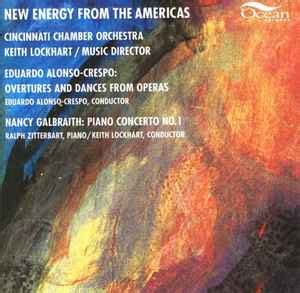
Published on Jul 16, 1997
Since I was a small boy, I have always enjoyed classical music –
thanks in part to the “Funk & Wagnalls Family Library of Great
Music” collection that A&P offered back in the mid-70s. True
story: I spent almost five years searching for a specific version
of Bach’s “Brandenburg Concertos” before I finally unearthed it on
CD. Though I mostly review rock on these pages, I still enjoy
kicking back once in a while with a good classical album.
But many people don’t realize that classical music didn’t die
with the great composers; it is still an art form which is alive
and well. Two composers, Eduardo Alonso-Crespo and Nancy Galbraith,
are prime examples of this, as highlighted on the disc
New Energy From The Americas. And while I’ll admit I’m still
partial to artists like Chopin and Mozart, the efforts of these two
composers are quite admirable.
Under the direction of Keith Lockhart (who has since become
famous as the third conductor of the Boston Pops), the Cincinnati
Chamber Orchestra makes a strong case to become as well-known as
other symphony orchestras around the world. Their performance on
this disc is incredible – and from what I could see on the
Internet, this could be one of the first recordings released by
this group. (This disc is also extremely hard to find; I couldn’t
find a listing for it on Music Boulevard, CD Now, or CD Universe –
though I’m sure they could order it for you.)
(Editor’s note: With the folding of Ocean Records, this one has
probably become even harder to find.)
Alonso-Crespo’s work is represented in the guise of four
selections from three of his works. Written in celebration of the
500th anniversary of the discovery of America,
Juana, la loca is an opera which has a truly “classical”
sound to it, as heard in the two selections from it. The overture
is especially noteworthy – the crests and ebbs of the music almost
make it feel like you are on the journey as well. The “Ballet
Music” selection takes a little time to get used to, but also
proves to be worth the effort.
The overture from
Yubarta, an opera calling to attention the plight of
endangered species, is more challenging. It is not as upbeat as
that from
Juana, la loca – but maybe it was not meant to be. I tend to
be reminded of Tschaikovsky’s
Pathetique symphony when I hear this, but I can’t say I’ve
totally warmed up to it just yet. The final selection, a waltz from
Pursi, is equally as challenging – it has somewhat the
traditional flow of a waltz, but it does not always stay in that
rhythm pattern clearly. Under the leadership of Alonso-Crespo as
conductor, he makes sure the Cincinnati Chamber Orchestra stays
true to the feeling of his works. Alonso-Crespo proves himself to
be a venerable composer in his own right, and I am now interested
in hearing the full versions of some of his works.
Galbraith is represented here with “Piano Concerto No. 1,” a
work which again is challenging. The first movement gives the
orchestra a chance to build up the mood before the piano – played
by Ralph Zitterbart – comes in to set the mood. Personally, when I
think of a piano concerto, I expect the piano to be the centerpiece
of the work. However, in the case of this concerto, it often seems
as if the piano is secondary to the performance of the ensemble –
which can be distracting.
The second movement is the most challenging, with a mood of
suspense built by a subdued piano and a faint tremolo of the string
section. Everything resolves itself well in the third movement, and
the piano tends to step forward a little bit more.
This work is one which, quite frankly, one probably will not
appreciate with one cursory listen. I listened to the work five
times, and while I do enjoy the concerto more, I still don’t think
I’ve captured all the nuances. (This one, by the way, is best
listened to with headphones, to capture some of the subtleties of
the performance.)
To those who are most familiar with more established works and
better-known composers,
New Energy From The Americas serves as both a wake-up call
as well as a challenge. It reminds us that there are still
composers out there trying to preserve a beautiful form of music,
but it also tries to erase an accidental stigma classical music has
thrust upon itself. The scene has tended to keep only certain
composers’ works alive (remember the torture of – do I have his
name right? – Salieri in
Amadeus?), so when a different name comes to the front, it’s
harder to accept.
New Energy From The Americas is a wonderful showcase – not
only for the two composers whose work is highlighted here, not for
the young conductor who is at the top of his game, not even for the
Cincinnati Chamber Orchestra. It is a showcase for classical music
itself – far from dead, though unjustly far from the eyes of many
music lovers. Finding this one is going to be a tough search, but
it is a rewarding one.